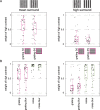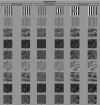The effect of spatial structure on binocular contrast perception
- PMID: 36326743
- PMCID: PMC9645364
- DOI: 10.1167/jov.22.12.7
The effect of spatial structure on binocular contrast perception
Abstract
To obtain a single percept of the world, the visual system must combine inputs from the two eyes. Understanding the principles that govern this binocular combination process has important real-world clinical and technological applications. However, most research examining binocular combination has relied on relatively simple visual stimuli and it is unclear how well the findings apply to real-world scenarios. For example, it is well-known that, when the two eyes view sine wave gratings with differing contrast (dichoptic stimuli), the binocular percept often matches the higher contrast grating. Does this winner-take-all property of binocular contrast combination apply to more naturalistic imagery, which include broadband structure and spatially varying contrast? To better understand binocular combination during naturalistic viewing, we conducted psychophysical experiments characterizing binocular contrast perception for a range of visual stimuli. In two experiments, we measured the binocular contrast perception of dichoptic sine wave gratings and naturalistic stimuli, and asked how the contrast of the surrounding context affected percepts. Binocular contrast percepts were close to winner-take-all across many of the stimuli when the surrounding context was the average contrast of the two eyes. However, we found that changing the surrounding context modulated the binocular percept of some patterns and not others. We show evidence that this contextual effect may be due to the spatial orientation structure of the stimuli. These findings provide a step toward understanding binocular combination in the natural world and highlight the importance of considering the effect of the spatial interactions in complex stimuli.
Figures
















